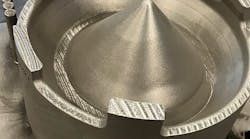There always will be buyers who will jump on a new technology (“Cool! I’ve got to have this!”), and this is as true in business as it is for consumer products. Some of these “early adopters” will take on a new technology because it is “nice to have”. Many others will not even take a closer look at it, as they perceive it as just exactly that: nice to have, but not something they need.
However, many business executives and managers will approach new products and technologies with curiosity, as well as a healthy dose of skepticism. They will ask themselves if this “new mouse trap” really works, or is justifiable or even applicable to their particular operation. If they can answer all of these questions positively, they still may choose not to implement a new technology (after all “change hurts”) unless their customers force them to use it (“You will not supply our castings if you don’t use XYZ!”)
At that point the managers might see the new technology as a “necessary evil,” and use it to checkoff the supplier evaluation form, but they won’t truly implement the technology as they are not convinced that it adds any value to their operation. However, truly new technology (industry transforming technology), has a way of proving itself in use, and to penetrate an organization in a way that often changes the entire operation. Either right from the start or over time, a business actually changes the way it manufactures and markets products, communicates with customers and establishes relationships, differentiates itself from competitors, improves internal communication, increases productivity, reduces material and energy consumption, as it reduces scrap, rework, and labor costs, maybe even attracts and retains skilled labor. The technology becomes an indispensible tool with an impact on the entire business – an “indispensible business tool”!
What technology are we talking about here? What technology has been introduced to the foundry industry within the last 30 years that could possible do all of these things? None?
I can think of one: Casting process simulation. The initial idea behind casting process simulation is to provide foundries (primarily) with software enabling them to move the trial-and-error process from the shop floor (the “real world”) into the computer (the “virtual world.”) If that actually works, it is certainly a cool technology, initially revolutionizing how the engineering department works.
Wait, isn’t that exactly what we need in marketing and sales? Isn’t an animated, to-the-point presentation much more persuasive to a customer or designer than a verbal, “You’ve got to change the design!” message? Isn’t that a way to differentiate a foundry from all the other “commodity providers,” and doesn’t it make me a “value adding partner”? Can’t I use this to communicate to the shop floor the process parameters that we need to maintain, to hit our process window for making good parts at minimum costs (minimum material, energy and time consumption.) Doesn’t it lead to happy customers when we make castings right the first time, and deliver them on time? Isn’t that what employees look for – a meaningful job, working with high-tech tools, contributing to the success of the entire operation?
Not only has the use of simulation evolved, with many foundries having fully implemented this technology in their operations, but simulation tools have evolved, too. Initially only able to predict hotspots, sophisticated tools are now simulating the entire casting process, including predicting micro structures, mechanical properties, stresses and distortion, and die life. They also use automatic optimization to find the optimal gating system or process parameter combination, literally by themselves. Simulation is not a static product. It continuously evolves. It’s like buying a bike that develops itself into a car, and soon becomes a plane! One of the latest developments is simulating the core and mold making process and the effects of dissolved gases on casting defects.
Every industry has 20% leaders, 50% average performers, and 30% laggards. If you are reading this, you are likely not a laggard. It’s likely you are among the leaders, or the upper ranks of the average, on your way to being a leader.
Being a leader has nothing to do with size. We have customers with 12-15 employees using our “expensive” product! As you are likely using casting process simulation, I challenge you to ask yourself if you have fully integrated simulation into your operation and use it to its fullest potential. Did you buy it as nice-to-have but still use it as nice-to-have? Did you buy it as necessary-evil but still use it as necessary-evil? Or, is your software/hardware at the latest level? Is your personnel well trained to use all of your simulation tool’s functionalities, features, and applications? Is your operation using it in marketing, sales, and communication with customers, as a tool to attract and retain skilled labor? Is simulation integrated as an essential business tool of your operation? If it’s not, it can be one.
Ask your simulation provider what is available to help you achieve that goal. A good casting process simulation vendor becomes your partner in daily challenges by providing the tools, the functionality, and application support, as well as training, not only to operate the software, but to use it to make better castings, faster and at lower cost.
You still don’t use casting process simulation because it is just a nice-to-have? Have another look. There is a simulation tool out there for every foundry to participate in the transformation of an industry challenged by increasing material, energy, and labor-cost pressures, environmental requirements, and evermore demanding customers. Casting process simulation is the perfect (necessary) business tool to face these challenges.
Christoff Heisser is the president of MAGMA Foundry Technologies Inc. Visit www.magmasoft.com .










